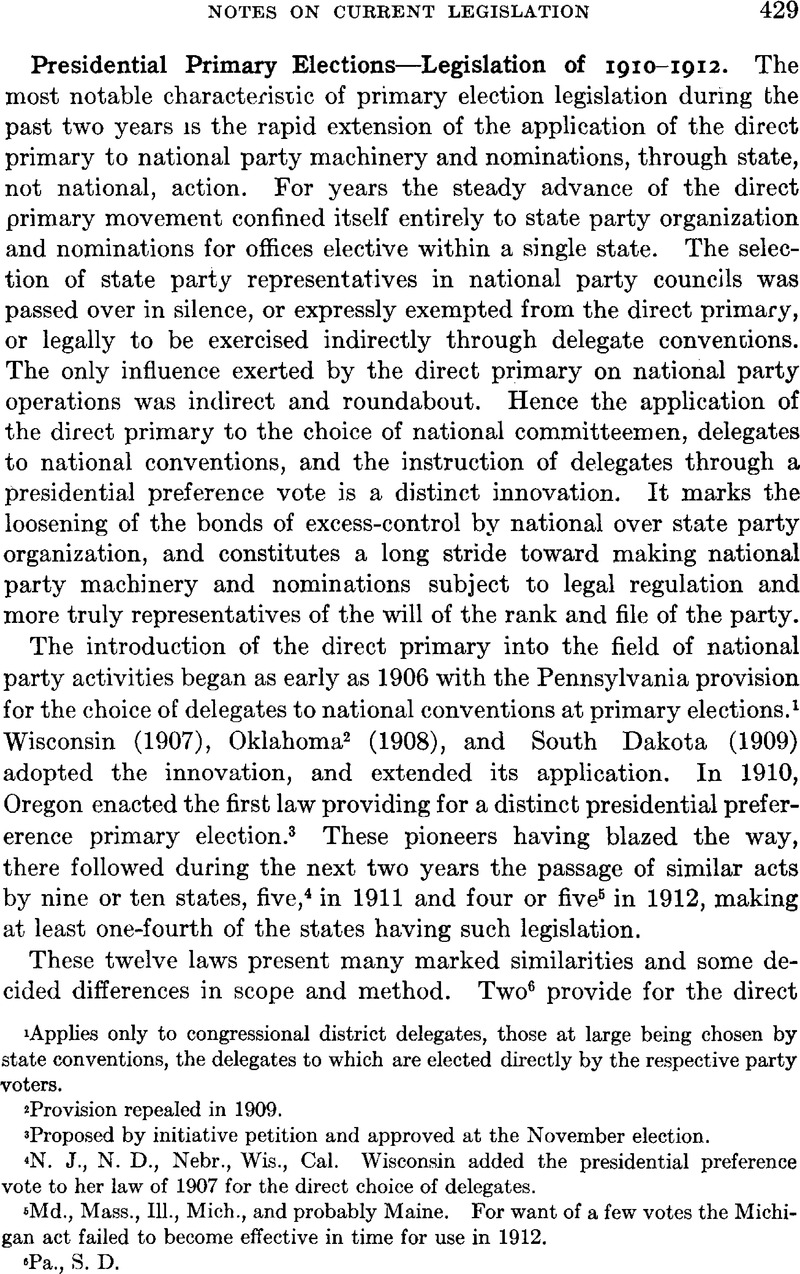No CrossRef data available.
Article contents
Presidential Primary Elections—Legislation of 1910–1912
Published online by Cambridge University Press: 02 September 2013
Abstract

- Type
- Notes on Current Legislation
- Information
- Copyright
- Copyright © American Political Science Association 1912
References
1 Applies only to congressional distriet delegates, those at large being chosen by state conventions, the delegates to which are elected directly by the respective party voters.
2 Provision repealed in 1909.
3 Proposed by initiative petition and approved at the November election.
4 N. J., N. D., Nebr., Wis., Cal. Wisconsin added the presidential preference vote to her law of 1907 for the direct choice of delegates.
5 Md., Mass., Ill., Mich., and probably Maine. For want of a few votes the Michigan act failed to become effective in time for use in 1912.
6 Pa., S. D.
7 Md., Ill., Mich.
8 Ore., N. D., Wis., N. J., Nebr., Cal., Mass.
9 In all but two states, the direct choice of delegates includes alternates, both district and at large. California provides for the choice of alternates by the regular delegates and Wisconsin by the state central committee. In five states, Ore., Nebr., N. D., Wis., and Mass., the presidential preference primary applies to the vice-presidency also.
10 S. D., N. D., Nebr.
11 Wis., N. J., Md., Mass., Ill.
12 Ore., N. D., Nebr., Cal., Mich.
13 Wis., N. D., N. J., Cal. Mass., Mich.
14 S. D., Ill., Pa., Ore., Nebr., Md., the last four by advancing the date of their general primary in presidential years.
15 Nebr. requires 500 signatures in each of her 6 congressional districts, if not more than 5% of total party vote; S. D. and N. D., only 1% of state party vote.
16 Varies greatly in different states: only 100 in N. J. and 250 in Mass. for all delegates, while 500 in Nebr. for district delegates and 3,000 for those at large.
17 Number required in Nebr., 25; Mich., 100; Mass., N. J., Ore., Wis., 1,000; Cal. and N. D., 1% of state party vote.
18 Pa., Wis., Nebr., N. J., Mass.
19 S. D., Ore., N. D., Cal., Md.
20 In Md. all the delegates are chosen by a state convention made up of delegates chosen directly on the date of the presidential preference vote. The result of the presidential preference vote is not ascertained as is usual in primary laws, by adding up the total vote for a candidate throughout the State. The vote of each county and district is considered by itself, and the carrying of any county or district by a candidate merely serves legally to instruct and require its delegates to the state convention to vote for him. Not the party voters but the state convention voting by counties and districts under the unit rule as instructed by the primary vote formally and legally makes the presidential preference nomination.



Comments
No Comments have been published for this article.